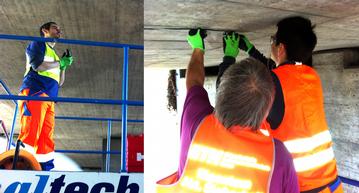Bridge Monitoring
As part of our work on Infrastructure Monitoring, the Chair has instrumented a number of roadway and railway bridges across Switzerland. The data obtained from the sensors allow us to better assess the condition of existing bridges, as well as their capacity to withstand extreme loads and weather conditions. Below we offer some details on past and ongoing monitoring projects:
ÜF Bärenbohlstrasse
In a project funded by the external page Federal roads Office (FEDRO), the group has installed an accelerometer sensor network on the ÜF Bärenbohlstrasse, a bridge over the A1 Highway of the Northern Overpass, Zürich. The bridge was recently demolished and replaced by a wider structure, able to carry more intense traffic load.

8 custom made triaxial accelerometers have been installed in a single day deployment under the deck of the Bärenbohlstrasse bridge with the aim of conducting Structural Identification for condition assessment of the bridge structure.
A series of tests including, impact/shaker and truck load tests, has also taken place, allowing us to assess the structural capacity and residual life of the bridge.
Crew:
Prof. Dr. Eleni Chatzi, Dr. Minas Spyridonakos, Dominik Werne, Thomas Jaggi, Roman Klis, Yunus Harmanci
SU Unterwalden (Sempach)
The SU Unterwalden railway bridge is located between the Unterwalden-Sempach railway stations, and is owned by Swiss Federal Railways (SBB). The bridge is a typical short span structure, with the unique feature of being whly constructted from ultra-high performance fiber reinforce concrete (UHPFRC). The use of this rather novel material renders the structure an interesting object for monitoring and validation of its design. A sensor network comprising easily deployable and low-cost sensors, such as accelerometers, tiltmeters, strain gauges, a laser distometer and a temperature & humidity sensor, was installed on the structure. This will offer a deeper insight into the structural behavior of the bridge within the next 2 years, as well as the performance of UHPFRC as structural material.
Chillon Viaduct
Located at the shore of Geneva Lake, in Switzerland, the Chillon viaducts are two parallel structures consisted of post-tensioned concrete box girders, with a total length of 2 kilometres and 100m spans. Built in 1969, the bridges currently accommodate a traffic load of 50.000 vehicles per day, thereby holding a key role both in terms of historic value as well as socio-economic significance. Although several improvements have been carried out in the past two decades, recent inspections has demonstrated an alkali-aggregate reaction in the concrete deck slab reducing its strength. In order to strengthen the concrete deck and slow down further ASR, a layer of 40 mm of Ultra High Performance Fiber Reinforced cement-based Composite (UHPFRC), incorporating rebars, was cast over the slabs, acting as a waterproof membrane and providing significant increase in resistance via the UHPFRC - RC composite action, in particular of the deck slab.
Two years after completing the works, a Structural Monitoring campaign was installed on the deck slab in one representative span, based on accelerometers, strain gauges, thermal and humidity sensors. This campaign seeks to reveal information on the behaviour of UHPFRC-concrete composite systems, such as increase in stiffness, fatigue strength, durability and long-term performance.
The Buna Bridge
In the last decade, Ultra High Performance Fibre Reinforced cement-based Composites (UHPFRC) have been increasingly implemented for rehabilitation and strengthening purposes, rendering outstanding results. Despite this field being thoroughly explored and extensive literature already being available with respect to concrete and UHPFRC solutions, with particular focus on bridges or maritime environments, research on UHPFRC combined with steel in structures such as steel decks or railway bridges has only recently surfaced. An example of the latter is the Buna Bridge, a Croatian riveted steel structure, constructed in 1893, repaired in 1953, and decommissioned since 2010.
The structure was transported in a laboratory setting for testing, envisioning a later strengthening by a prefabricated UHPFRC slab, connected to the original structure by means of steel studs. The testing campaign includes static and dynamic experiments featuring state-of-the-art monitoring systems such as embedded fiber optics, acoustic emission sensors and digital image correlation. The information obtained prior rehabilitation serves for characterization of the actual condition of the structure and allows the design of the strengthened solution.
Crew:
Prof. Dr. Eleni Chatzi,Henar Martín-Sanz, external page Domagoj Damjanovic, external page Irina Stipanovic


